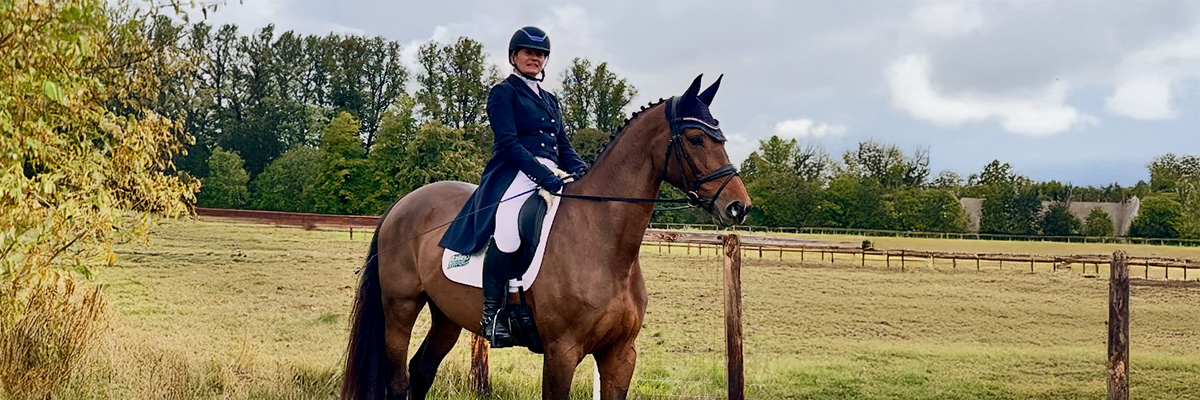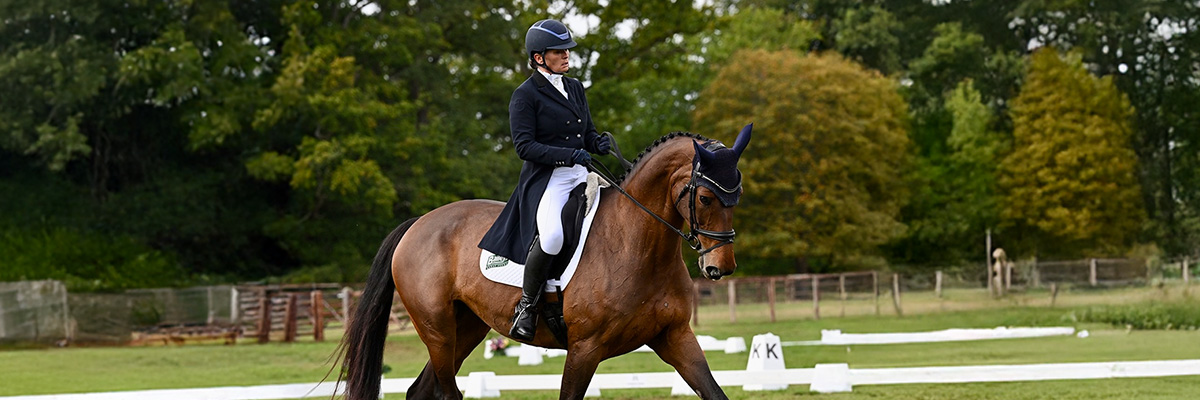
About the Author


Tamsin Drew is an accomplished 2* 3 day event rider and proud Harry Hall ambassador who brings years of competitive experience to her expertise. Currently competing her mare 'Isn't It Special' (stable name Kate), Tamsin has successfully brought multiple horses through the eventing levels, from BE100 to international CIC competitions.
Previous winner of the prestigious Shearwater Owner Rider Award, Tamsin balances her eventing career with a demanding full-time role as a financial advisor in London. Her down-to-earth perspective and genuine understanding of balancing work-life-horses commitments make her insights invaluable for anyone looking to improve their competitive performance. Follow Tamsin's journey here.
Quick Memorisation Tips
- Draw your test layout repeatedly until it becomes second nature
- Walk through the test on foot using arena markers or cones
- Break the test into logical sections rather than learning it as one long sequence
- Use verbal cues and narration to engage your auditory memory
- Practise writing the test from memory to identify weak spots
Introduction
Struggling to memorise your dressage test? You're not alone. As a 2* three-day event rider and Harry Hall ambassador, I've developed foolproof techniques that have helped riders master even the most complex test patterns – and I'm sharing them all in this comprehensive guide.
Whether you're preparing for your first Prelim or tackling an advanced Elementary test, knowing how to memorise a dressage test effectively can make the difference between a confident, flowing performance and that dreaded moment of going blank halfway through your test. The good news? With the right dressage test memorisation techniques, you can train your brain to recall every movement as naturally as you'd ride a familiar hack.
In this guide, I'll walk you through my five-step system for memorising dressage tests quickly and effectively. From visual mapping techniques that work for all learning styles to practical tips for using technology and physical rehearsal, you'll discover exactly how successful riders commit their tests to memory – and keep them there when competition pressure mounts.
These aren't just theories – they're battle-tested strategies I've refined through years of competing. By the end of this article, you'll have a complete toolkit for dressage test memorisation that transforms test learning from a stressful chore into a systematic, confidence-building process.


How Do You Visualise the Test Layout?
Drawing your test layout on paper remains one of the most effective memorisation techniques I've encountered. There's something powerful about the physical act of sketching out each movement that embeds the pattern into your muscle memory.
Start with a blank arena diagram and trace through each movement with your pen. Draw the circles, mark the transitions, and note the exact letters where changes occur. I recommend drawing the same test at least five times before you feel confident with the basic layout.
Use arena letter markers for better understanding by always referencing the specific letters in your diagrams. Rather than thinking "circle somewhere in the middle," train yourself to think "20-metre circle at A" or "transition at K." This precision becomes crucial when you're under competition pressure.
The beauty of this visual approach is that it works for all learning styles. Even if you're primarily an auditory or kinaesthetic learner, the act of repeatedly drawing creates multiple memory pathways that reinforce each other when you need them most.
Why Should You Use Verbal Cues and Narration?
Speaking each movement out loud as you visualise riding the test engages your auditory memory in powerful ways. I often catch myself muttering test sequences under my breath – and there's solid reasoning behind this habit.
Create short, memorable phrases for complex sequences. For example, instead of trying to remember "medium trot from M to K, then working trot, then leg yield left from E to B," develop a verbal shortcut like "medium-working-yield left." These condensed verbal cues become anchors that help you navigate through longer, more complex sections.
This technique particularly helps auditory learners who process information better through sound than visual or physical input. Even if that's not your primary learning style, adding verbal elements creates additional memory reinforcement that proves invaluable during those crucial moments in the arena.
Try recording yourself narrating the entire test, then listen back during car journeys or while doing yard work. You'd be surprised how effectively this passive reinforcement works.


What's the Value of Walking Through the Test?
Walking or riding the test on foot provides kinaesthetic learners with the physical movement they need to lock patterns into memory. This technique transforms abstract diagrams into concrete spatial relationships your body can remember.
Set up cones or markers in a field, or if you have access, walk through an actual dressage arena. Using cones or markers in a field or yard allows you to practise anytime, making this one of the most accessible memorisation methods.
As you walk, maintain the same rhythm you'd use when riding. Step through your transitions, pause at halt markers, and physically turn through your circles and serpentines. This embodied learning creates what I call "muscle memory for the mind" – your body learns the flow and timing of the test alongside your cognitive memory.
Physical movement enhances memorisation because it engages multiple senses simultaneously. You're seeing the arena, feeling the turns, and processing the spatial relationships all at once. This multi-sensory approach creates robust memory traces that remain accessible even when competition nerves strike.
How Can Technology Help Your Memorisation?
Modern dressage test apps and visualisation tools have revolutionised how riders prepare for competition. Apps like Dressage TestPro offer interactive diagrams and timing features that complement traditional memorisation methods beautifully.
Combine digital tools with mental imagery by using apps to verify your mental rehearsals. After visualising a test sequence, check your accuracy against the app's diagram. This combination approach catches errors before they become ingrained habits.
I find these tools especially useful just before competition when you need quick, accurate reference without carrying bulky test books. Having the test available on your phone means you can review patterns during warm-up periods or while waiting for your class.
However, remember that technology should supplement, not replace, active memorisation techniques. Apps are fantastic for verification and quick reference, but they can't replicate the deep learning that comes from repeated mental and physical rehearsal.
How Do You Break Down Complex Test Patterns?
Breaking the test into 3-5 logical sections transforms overwhelming sequences into manageable chunks. Rather than trying to memorise a complete Novice or Elementary test as one continuous flow, divide it into natural segments that make sense together.
Typically, I structure sections around major movements or arena locations. For example: "Opening section (A to M)", "First circle work (M to F)", "Diagonal work (F to H)", "Closing section (H to A)." Each section becomes its own mini-test that you can master independently before linking them together.
Focus on transitions as memory anchors because they're the natural connection points between sections. Transitions are also where most memory lapses occur, so giving them extra attention pays dividends during competition.
Once you've mastered individual sections, practise linking them smoothly. This staged approach builds confidence systematically and helps you identify exactly where your memory might be weakest.
Expert Insights from Competition Experience
After years of competing at 2* level, I've learned that the riders who consistently perform well aren't necessarily the most talented – they're the most prepared. The difference between a good test and a great test often comes down to mental preparation and confidence in your pattern knowledge.
I've seen talented combinations lose significant marks simply because the rider was mentally juggling the test sequence instead of focusing on quality execution, reflects my experience coaching other event riders. When you truly know your test inside and out, you free your mind to concentrate on the subtleties that judges really notice – straightness, rhythm, connection, and accuracy.
One breakthrough moment came when I started combining multiple memorisation techniques rather than relying on just one approach. Visual learners still benefit from physical rehearsal, and kinaesthetic learners can enhance their preparation with verbal techniques. The most effective approach uses several methods to create multiple memory pathways.


Frequently Asked Questions
What is the best way to memorise a dressage test?
The most effective approach combines multiple techniques: draw the test layout repeatedly, walk through it physically, use verbal narration, and break it into logical sections. Different riders respond to different methods, so experiment to find your optimal combination.
How long does it take to learn a dressage test?
Most riders need 3-5 focused practice sessions to memorise a test confidently. Start learning at least a week before competition to allow for thorough mental rehearsal and error correction. Complex tests may require additional time.
Are there apps that help with remembering dressage tests?
Yes, apps like Dressage TestPro provide interactive diagrams and can supplement traditional memorisation techniques effectively. However, use them alongside active learning methods rather than as standalone solutions.
Can I write down my test during competition?
No, carrying written test instructions into the arena results in elimination under British Dressage and FEI rules. All tests must be memorised completely, making thorough preparation essential for competitive success.
Conclusion from Harry Hall
Mastering dressage test memorisation transforms your competitive experience from stressful uncertainty to confident execution. These proven techniques – visual mapping, physical rehearsal, verbal reinforcement, and systematic breakdown – work together to create robust memory systems that hold up under pressure.
The key lies in starting your preparation early and using multiple approaches rather than relying on a single method. Dressage test tips become most effective when they're practised regularly and adapted to your individual learning style.
Remember, every accomplished dressage rider has faced the same memorisation challenges you're experiencing now. The difference lies in developing systematic approaches that build confidence alongside competence.
At Harry Hall, we understand the dedication required for competitive success. Just as we've supported riders with quality competition wear for dressage riders and personalised show clothing for decades, these memorisation strategies support your mental preparation for peak performance.
Ready to transform your test preparation? Start implementing these techniques today, and discover how confident memorisation enhances every aspect of your dressage performance. Explore our dressage gear collection to ensure you're fully prepared for competition success.
Begin with just one technique that appeals to your learning style, then gradually incorporate others as your confidence grows.
